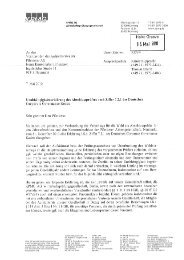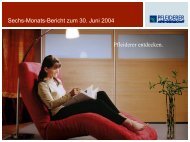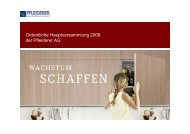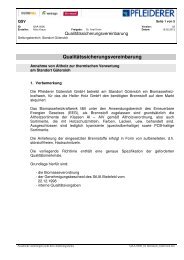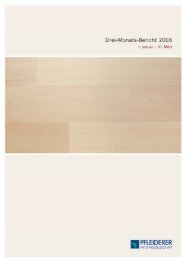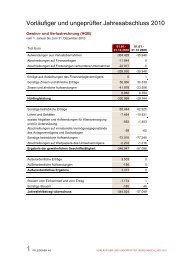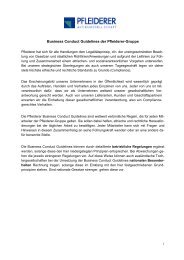PDF, 3.2 MB - Pfleiderer AG
PDF, 3.2 MB - Pfleiderer AG
PDF, 3.2 MB - Pfleiderer AG
Create successful ePaper yourself
Turn your PDF publications into a flip-book with our unique Google optimized e-Paper software.
Sales of receivables are treated within the Group in accordance with SFAS 140 (Accounting for<br />
Transfers and Servicing of Financial Assets and Extinguishments of Liabilities). In accordance<br />
with SFAS 140, a company has to recognize the financial and servicing assets that it controls and<br />
the liabilities that it has incurred and derecognize these financial assets when control has been<br />
surrendered in accordance with the criteria listed in SFAS 140.<br />
The Group treated the receivables transferred under an asset-backed securities program until<br />
June 2004 as a sale of receivables. Thereby, the transfer is only recognized as a sale when the<br />
receivables are beyond the reach of the Company and its creditors. This also applies in the case<br />
of the insolvency or other receivership of the creditor’s assets. In addition, the right to pledge<br />
or exchange the transferred receivables must be surrendered and the entitlement or obligation<br />
to repurchase them must be excluded. Active receivables were transferred and sold under an<br />
asset-backed securities program for the last time in June 2004. All the sold receivables had been<br />
collected and the asset-backed securities program was accordingly terminated by the end of<br />
October 2004.<br />
A factoring program commenced in July 2004 in the Business Segment Engineered Wood. Under<br />
this, the factor purchases the Group’s receivables up to an individual or total limit, and assumes<br />
the risk for the debtor’s insolvency (nonrecourse factoring). This is accounted for in the same<br />
way as the asset-backed securities program described above.<br />
Inventories<br />
Inventories are valued at the lower of cost or market on the basis of individual values or the<br />
weighted average method. The first in-first out method (FIFO) is also used in justified individual<br />
cases. Market value is generally determined by referring to replacement costs. The ceiling for<br />
determination of market value is the estimated selling price in the ordinary course of business<br />
less the estimated costs of completion and the estimated costs necessary to make the sale<br />
(net realizable value). The floor for determination of market value is the net realizable value less<br />
a normal profit margin.<br />
Production costs include direct material and production costs and an adequate portion of the<br />
material and production overheads resulting from the production process.<br />
All foreseeable risks in the inventories resulting from reduced saleability or obsolescence are<br />
reflected by appropriate provisions. Markdowns are recorded for slow-moving items.<br />
Use of Financial Instruments<br />
The Group transacts business worldwide in numerous international currencies, so that it is<br />
generally exposed to exchange rate fluctuations. <strong>Pfleiderer</strong> uses financial instruments in order<br />
to reduce various kinds of market risks.<br />
77<br />
FINANCIAL STATEMENTS/NOTES PFLEIDERER GROUP





